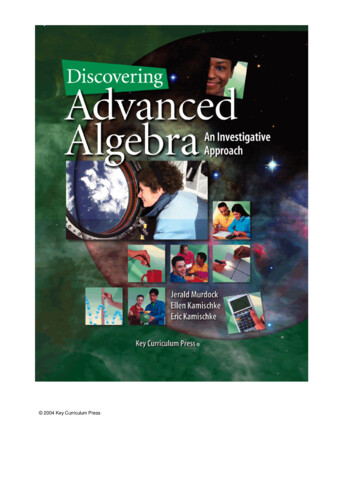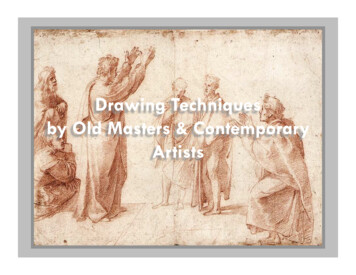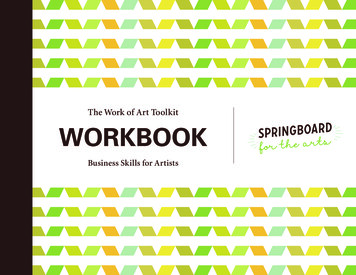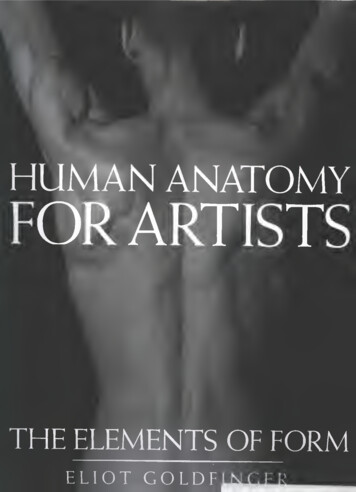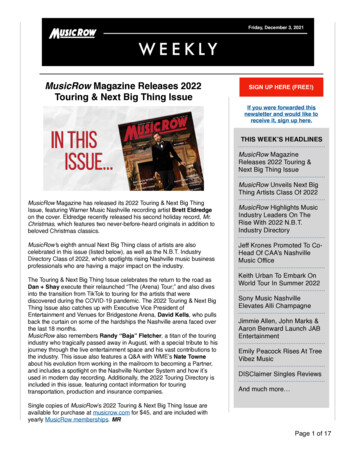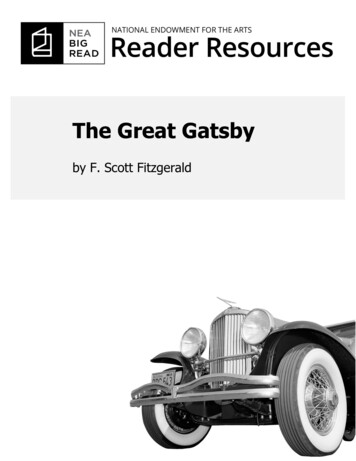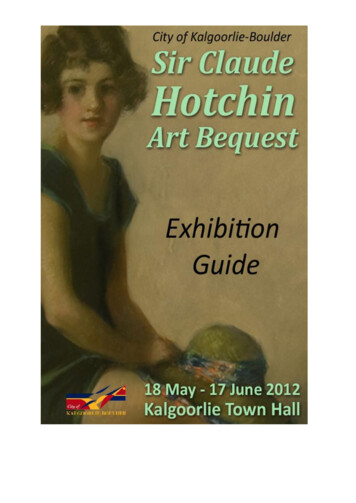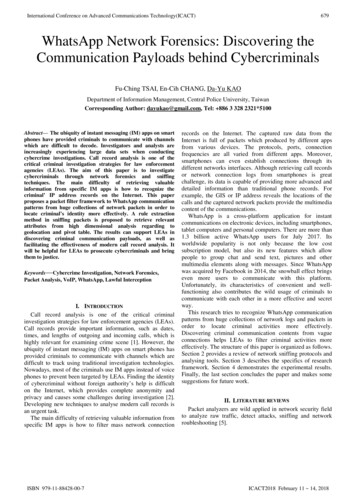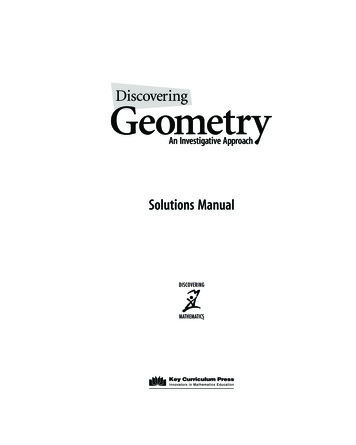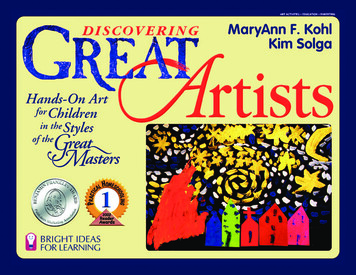
Transcription
GREATDISCOVERING rtistsHands-On Art for Childrenin the Styles of the Great MastersMaryAnn F. KohlKim SolgaillustrationsRebecca Van SlykeBRIGHT IDEASFOR LEARNING
CREDITSIllustrationsArtist PortraitsTypographyCover DesignCover IllustrationBack CoverRebecca Van SlykeKim Solgatextype, Trish Lemon, Dorothy Tjoelker-WorthenMaryAnn KohlChristina Critelli, age 6Trish Lemon, Joe ShahanISBN 0-935607-09-9Library of Congress Catalog Card Number: 97-71761COPYRIGHT 1996 MaryAnn F. Kohl and Kim SolgaAll rights reserved. No part of this book may be reproduced or transmitted in any formor by any means, electric or mechanical, including photocopying, without the writtenpermission of the publisher.Manufactured in the United States of America101st printing May, 1997Attention: Schools and BusinessesBright Ring Publishing, Inc.’s books are available for quantity discounts with bulkpurchase for educational, business, or sales promotion use. Please contact:Bright Ring Publishing, Inc.PO Box 31338Bellingham, WA 98228-3338office ph. 360-734-1601 fax 360-676-1271 order ph. 800-480-4278Publisher’s Cataloging in Publication Data(Provided by Quality Books, Inc.)Kohl, MaryAnn F.Discovering great artists : hands-on art for children in the styles of the greatmasters / MaryAnn F. Kohl, Kim Solga; illustrations, Rebecca Van Slyke.p. cm. – (Bright ideas for learning)Includes indexesISBN: 0-935607-09-9SUMMARY: Approximately 80 visual artists, from Giotto to Van Allsburg, arefeatured in this collective biography, which also includes instructions for artprojects which correspond to each artist’s style or technique.1. Artists – Biography – Juvenile literature. 2. Art – Technique – Juvenileliterature. I. Solga, Kim. II. Title. III. Series.N42.K64 1997709.2'2'024054QBI97-40470
DEDICATIONSIn memory of my parents, Jay and Betty Faubion, who read to me every night of my childhood. - MAKTo Nici, who was always willing to try out an art project for her mom. - KSACKNOWLEDGMENTSDeepest gratitude and praise to the young great artists who contributed to this book with their original works of art:Aaron Avsshai, age 12, Lake and SkyWatercolorAmanda Schwittay, age 7, Woven MatAmy King, age 7, Girl PortraitAshley Cole, age 6, Tesselating Puppy,inspired by a tessela from Dale SeymourPublicationsChad Noward, age 7, SquirrelChristina Critelli, age 6, BridgeChristina Critelli, age 6, Starry NightDavid Royce, age 7, Paper CollageDavin LaRue, age 5, Paper ShapesGeneva Faulkner, age 8, Mother, Baby &Angels, and Self PortraitHannah Kohl, ages 6-8, Queen, Wagon andPig, and One-Line Cat and HouseJackie Lemon, age 9, Tree HouseJacob Aiello, age 8, Baseball BoxJared Lollar, age 8, Invasion from MarsJenny Lemon, age 7, Chomp, and WigglyWatercolor DesignJesse Pennington, age 11, Foil DuckJesse Vander Hoek, age 8, FacialExpressionsJodi Drost, age 9, Quilt Scene, and WinterBarnJordan Drost, age 10, Dancing Cow, andLadder ChairKatherine Shelley, age 8, Asthma CampKatie Rodriguez, age 8, Girl’s ProfileKim Dettman, age 12, Cloudy SkyKim Solga, Student ArtKyle Casteel, age 8, Birthday PosterMadeline Vander Pol, age 7, Dog FeederMatt Means, age 8, smiling boy inphotographMegan Kohl, age 7, SunsetMelinda de Bruin, age 8, “You&Me”PictureMorgan Van Slyke, age 1, Paper CollageNici Smith, ages 9-12, Chalk Fish, RobotCollage, Wire Man, Cowboy Sculpture,Desert Watercolor, Watercolor Flower,Horse of DotsPeter James, age 7, JungleRob Harweger, age 8, Gallery PictureRyan Phillips, age 12, Name PlaqueSally Ann Mitchell, age 6, Egg FlowersScott Brandl, age 8, LoonTara McKinney, age 8, Pitcher with FlowersTatiana Huaracha, age 8, Camping Picnic,and Dinosasur with FoilThanks to Fred W. Smith, Mt. Shasta, California, for his photography throughout the book.Original art of the following artists is used with permission from Planet Art CD ROM Royalty Free Graphics, Beverly Hills, California:Dürer, Rhinoceros, 1500Magritte, c. 1950Toulouse-Lautrec, 1891, Moulin RougeKahlo, c. 1940, Self-PortraitMichelangelo, 1512, Father GodLa GoulueLimbourg Brothers, 1413, Tres RichesRaphael, 1510, Madonna della SectiaVan Gogh, 1888, SunflowersHeuresRembrandt, 1642, Night WatchLinnaeus, c. 1760, SunflowerRivera, c. 1945“A man paints with his brains and not with his hands.”- MichelangeloDedication3
IntroductionDiscovering Great Artists offers childrenhands-on activities to explore the stylesand techniques of the world’s greatestartists. Each art process focuses on onestyle and one artist. A brief biography andportrait of each artist adds depth andinterest to the art project. The mostimportant aspects of the art projects arediscovery, exploration, and individualcreativity. The finished product will be anindirect benefit.Discovering Great Artists introduceschildren to the great masters. Many greatartists will be familiar names, likeMichelangelo, da Vinci, Picasso, Rembrandtand van Gogh. Other names will perhapsbe new, such as Arp, Nevelson, Hokusai, orPaik. Each featured artist has a style that isreadily imitated and explored by children,with a life history that will inspire or adddepth to the experience. Try one or trythem all!Discovering Great Artists is a book ofexploring. Young children are usually mostinterested in the process of art, not thefinished product, and may or may notshow interest in the associated art historyor art appreciation. Many will be curiousand can absorb as much as their interestsallow. Most older children will want toknow more about the artist’s life and howit affected the artist’s style. No one is4 Introductionrequired to learn the history of each artistor the eras or movements they represent.The information on each page is offered asa source of reference and inspiration forinterested learners. Don’t be surprised ifchildren want to collect information aboutdifferent artists much the way they collectbaseball cards and statistics.Discovering Great Artists encourageschildren to learn by doing, to becomefamiliar with new ideas. If a childexperiences painting with the impastopaint van Gogh used in his swirling,expressive brushstrokes, then that childwill feel more comfortable and familiar asan older student or adult studying vanGogh. Imagine visiting a gallery in Parisand seeing that same impasto style by vanGogh in person! Many children haveexpressed that it is like meeting an oldfriend.The most important thing for the child isto explore new art ideas and techniques.Above all, the activities are “open-ended”.It is up to the child to decide exactly howhis or her work of art will turn out.Independent thinking is encouraged, whileskills and responsibility are enhancedthrough individual decisions.Discovering Great Artists offers artactivities to expand the creativeexperience and awareness of children inall aspects of the visual arts through:painting, drawing, printing, sculpture,architecture, and other manipulations of artmaterials. The activities in this book workwell for all ages and abilities, from themost basic skill level to the mostchallenging. Repeat projects often and seenew outcomes and learnings each time.Discovering Great Artists encourageschildren to expand their knowledge.Getting to know great artists will inspirechildren to read books, visit museums, goto the library, collect information, and lookat the world in a new way. They will beginto encompass a greater sense of history andart appreciation and see themselves in thescope of time. Perhaps they will be inspiredto carry art in their hearts as they grow anddevelop. They are already great artists inevery sense of the word.
Art ResourcesResources for wonderful art materials are everywhereyou look – in libraries, in stores, in museum shops, incatalogs, in the trash! Once you start looking, they willseem to appear out of nowhere! Some are free while othersrange from inexpensive to costly.Books with colorful reproductions of artwork are readilyavailable at libraries and bookstores. Posters and prints offamous artwork can be purchased from catalogs,bookstores, museum shops, or checked out from mostlibraries. Illustrations can be cut out of magazines and usedbooks, then mounted on cardboard to create small postersand cards. Many videos and slide sets are available forschool and home use. The internet offers connections withmuseums around the world, with thousands of greatpaintings to view. Visits to museums, art galleries and thestudios of local artists, give children eyewitness, hands-onexperiences with works of art. Free brochures and catalogsof expensive art prints can be cut apart and used in manyways. The following resources for books, prints and otherart history materials are suggested. Contact all of them fortheir free brochures and catalogs.BOOKS ABOUT ARTISTS FOR CHILDREN Eyewritness Art, seriesby Colin WigginsOver 10 books. Like having a private art gallery ormuseum. Available on Perspective, Watercolor, Monet,Manet, Goya, Renaissance, and more. PostImpressionism is excellent.Published by Dorling Kindersley, Inc., New York, NYLook at other publications by Dorling Kindersley. The Famous Artists, seriesOffers 8 excellent paperback books on famous artists,including Miro, Da Vinci, Michelangelo. Many others.Published by Barrons Education Series, Inc.,Hauppauge, NY The First Impressions, seriesOffers at least 17 titles developed especially for youngpeople (and old people who like things simple andsweet!), with each artist’s own works and life story.Titles include: Chagall, Cassatt, Frank Lloyd Wright,Rembrandt, Wyeth. Many more.Published by Harry N. Abrams, Inc., New York, NY Getting to Know the World’s Greatest Artists, seriesby Mike VeneziaGives children a delightful glimpse into the lives of 13different artists and their works.Published by Children’s Press, Chicago, IL Mommy, It’s A Renoir, seriesProvides a system of games and activities that teachchildren about great artists and their paintings.Published by Parent Child Press, Hollidaysburg, PA Talking With Artistsby Pat CummingsConversations with 14 favorite children’s bookillustrators including Chris Van Allsburg, The PolarExpress.Published by Bradbury Press, New York, NY Weekend with Picasso, seriesJust one of the titles in an interesting series of storieswith imaginary visits to great artist’s studios.Published by Skira/Rizzoli, New York, NY Women Artists for Children, seriesOffers a special focus on the life and techniques ofseveral great artists, including O’Keeffe, Kahlo, andCasatt.Published by Little, Brown, and Co., Boston, MAPOSTERS AND ART PRINTSWrite to each supplier for a catalog, price, and availability.Many of the catalogs will be sources for cut-and-paste activitiesusing prints of great art.Prints, Posters, and Laminated Reproductions Art Extension Press, Box 389, Westport, CT 06881Dover Publications (Print Portfolios), 31 East 2nd St.,Mineola, NY 11501 Parent Child Press (Art Prints for Children), PO Box 675,Hollidaysburg, PA 16648 Shorewood Reproductions, 27 Glen Rd., Sandy Hook,CT 06482 University Prints, 21 East St., Winchester, MA 02890Postcard Art Reproductions Abbeybille Press, Inc.,488 Madison Avenue, New York, NY 10022 Dover Publications - see above Parent Child Press (Mommy, It’s A Renoir materials)see books above Pavilion Books Limited,196 Shaftesbury Avenue, London WC2H 8JL, England Running Press, 125 S. 2nd St., Philadelphia, PA 19103 Bright Ideas for Learning, series, art activity books byMaryAnn F. Kohl, Bright Ring Publishing, Inc.,PO Box 31338, Bellingham, WA 98228-3338 Crizmac, PO Box 65928, Tucson, AZ 85728 KidsArt, art education booklets,PO Box 274, Mt. Shasta, CA 96067 Dale Seymour, PO Box 10888, Palo Alto, CA 94303 Davis Publications, 50 Portland St.,Worcester, MA 01608 Wilton Programs, PO Box 541, Wilton, CT 06897Museum Reproductions Metropolitan Museum of Art, Special Services Office,Middle Village, NY 11381 Museum of Fine Arts, PO Box 1044, Boston, MA 02120 Museum of Modern Art, 11 West 53rd St.,New York, NY 10019 National Gallery of Art, Publications Services,2000 B. South Club Dr., Landover, MD 20785 St. Louis Art Museum, Resource Center,Forest Park, St. Louis, MO 63110-1380 Whitney Museum of Art, 945 Madison Ave.,New York, NY 10021 museum gift stores all local art galleries and museums with artTHE INTERNET Museums and galleries around the world have sites onthe internet, with more added each month. This is a newand changing medium. Our best recommendation is touse a search option to find names of individual artists ormuseums. These searches will yield the most currentinformation, and by following the links suggested, aworld of information and images will be discovered.DON’T FORGET The public library has the most to offer for children’scuriosity, found both in the children’s and the adultdepartments. Enjoy the discovery of searching formaterials to supplement Discovering Great Artists basedon the curiosity of each individual child. Free catalogs are available from museums and museumshops, filled with reproductions of great art that can becut apart to your heart’s content!Programs, Textbooks, Newsletters, and Other Books Art Image Publications, PO Box 568,Champlain, NY 12919 Art Media, Etc., 1905 Studebaker Pl.,Gold River, CA 95670Art Resources5
IconsPositioned in the upper right corner of each art activity pageare icons which help the parent, teacher, or young artist select aparticular project as to any of the following:EXPERIENCE LEVELAssists in choosing, not limiting, choices of art experiences,with stars to indicate difficulty, and if adult supervision may behelpful.EASY- BEGINNINGartists with little art experienceMODERATE-INTERMEDIATEartists with some art experience and skillINVOLVED-EXPERIENCEDartists with a variety of art experiences and practiceAge and skill do not necessarily go hand and hand. Therefore,the “experience icon” flags the projects most appropriate for newor beginning-level artists, mid-level artists with some experience,or advanced-level artists with greater experience who work moreindependently. However, all children can explore all projectswhether the skill level matches their own or not - they maysimply need a little more time to work or extra help with difficultsteps. And remember, most experienced artists will also enjoy theeasier levels, too.ART TECHNIQUEShows what art medium or technique is utilized in the project.PAINT/DYEPRINT NG AND PREPARATIONIndicates the degree of involvement and planning time for theadult in charge.EASYMODERATEINVOLVED6 IconsSCULPT
IconscontinuedARTIST STYLEGreat artists from the past and present are often grouped intodescriptive movements, styles, or eras. These are described in moredetail in Chapter 6, under Great Art Words p.132-138. Some artistsare found grouped under more than one style and still others aredifficult to place in any one particular style. The more that artistsand their techniques are explored, the easier it is to see how they fitinto categories. Don’t expect to know this all at once! It can takeyears of enjoyment, discovery, and study. For now, they arepresented for the curious-minded who wish to know more and tohelp categorize the unique styles of each great ONISMEXPRESSIONISMNATURALISMRENAISSANCEBAROQUEFOLK ARTOP AND POP SMCHILDREN’S BOOKILLUSTRATORIMPRESSIONISMPOST IMPRESSIONISMUKIYO-E(EDO PERIOD)Icons7
Chart of Contentspagegreat artist3456-78-1011-36Dedication & AcknowledgmentsIntroductionArt ResourcesIconsChart of ContentsChapter 1Long, Long AgoRenaissance & Post RenaissanceGiotto1266-1337Limbourg Brothers1375-1416Ghiberti1378-1455Van ticelli1445-1510Da Vinci1452-1519Da langelo1475-1564Michelangelo1475-1564El 9Audubon1785-1851Courbet1819-1877Chapter 2Sunny & FreeImpressionists & Post 637-563839404142438 Chart of Contentslifetimeart activityartist styleart techniquechild leveladult preptimeEgg PaintBook of DaysFlorentine ReliefTriptych PanelLeaf Painting with SilverProfile PortraitArt in the RoundDrawing Things ApartDa Vinci InventionWood Block PrintMother & BabyFresco PlaqueLie-Down PaintingDrawing Tall FiguresChalk Light FaceMaking Faces!Shadowy FacesBotanical IllustrationsPortrait on LandscapeHand Colored PrintsCloudscapeSurimono GreetingNature NotebookPalette Knife paintdrawdrawdraw / nt / drawprintpaintdrawdrawpaint Still-Life in Melted CrayonDabble in PaintResist in MotionChalk on ClothTexture PaintsWilderness awchalkpaintpaint
pagegreat 1926Tempera MonoprintImpressionistRenoir1841-1919Mixed Media Still-LifeImpressionistVan Gogh1853-1890ImpastoPost ImpressionistVan Gogh1853-1890Starry NightPost ImpressionistCézanne1839-1906Seeing Shapes Still-LifePost ImpressionistRousseau1844-1910Jungle PrintsPost ImpressionistRodin1840-1917Carving ClayPost ImpressionistGauguin1848-1903Surprising ColorsPost Impressionist/ NabisToulouse-Lautrec1864-1901Event PosterPost ImpressionistSeurat1859-1891Pointillist Color CardsPost Impressionist /PointillistVuillard1868-1940Artist’s StudioPost Impressionist/ NabisRussell1864-1926Western SunsetImpressionistChapter 3Wild & WackyExpressionists, Abstract, Abstract-Expressionists, Cubists, Dadaists, & SurrealistsMatisse1869-1954Story Color CollagePost Impressionist/FauvistMunch1863-1944Clay Facial ExpressionsExpressionistKandinsky1866-1944Painting ht Line DesignAbstract/DeStijlKlee1879-1940One Line DesignsExpressionistStella1880-1946Mixed Media LinesAbstractEscher1889-1972Tessellation DesignAbstractCalder1889-1976Standing MobileAbstractMoore1898-1986Carving StoneAbstractBraque1882-1963Cubist CollageCubistPicasso1881-1973One Color PaintingCubistPicasso1881-1973Fractured FriendCubistRivera1886-1957Giant Projector MuralSocial RealistDuchamp1887-1968Happy Accident StringDadaistArp1887-1966Muse of Chance CollageDadaistOppenheim1913-1985Wacky Work of DadaDadaistChagall1887-1985Scenery MuralSurrealistMagritte1898-1967Giant Tennis ShoesSurrealistDali1904-1985Dream PhotographsSurrealistGiacometti1901-1966Sticks ‘n StrawsSurrealistKahlo1910-1954Special Self-PortraitSurrealistWright1867-1959Box House ArchitectModernChapter 4Art Today EverywayPop, Op, Folk, Modern, Cartoonists, Photojournalists, & Children’s Book IllustratorsGrandma Moses1860-1961Busy Folk Art SceneFolk ArtRockwell1895-1978Tell-a-Story IllustrationsRomanticO’Keeffe1887-1986Close-Up Flower PaintingRealistWyeth1917First SnowRealistLange1895-1965Photo Story rt activityartist styleart techniquechild leveladult aintpaintpaintpaint, cut cutsculptpaintdrawdraw / sculptpaint / drawdrawsculptsculptcutpaintdraw / cutdraw / paintpaintcutsculptpaintpaintcut / drawsculptdrawsculpt drawdrawpaintpaintphotography Chart of Contents9
0141142great 3Warhol1930-1987Ringgold1930Davis1946Van Allsburg1849Chapter 5Make It & Play ItGames & Child-Made ActivitiesChapter 610 Chart of Contentsart activityartist styleart techniquechild leveladult preptimeABC PhotographySeries DrawingCubi StructureDizzy Op ArtAction SpatterPortrait Box CollageScrap Box ArtCombinesBIG JunkWalk Through SculptureTransformationsRobot PeopleComic DotsLots of Me!Quilted WorkComic CreaturesGlowing HousePhotojournalistRealist & ModernAbstract ExpressionistOpAbstract pPopModernCartoonistChildren’s Book lptcutsculptsculptsculptcut / sculptpaintcutdrawdrawpaint Great Artist CardsMasters MatchMaster-PuzzlepieceMasters Scrap BookSmart Art CardsGreat Art CookiesGreat Art DominoesGreat Art Coloring PagesGreat Time LineHappy Birthday, Mr. PicassoGallery WalkMasterpiece MontageMap of HonorYou & Me Notebookcard gamematching gamepuzzle gamecataloging activitymatching gamecooking activitymatching gamecoloring activitysequencing activityparty activityexhibition activitydrama activitygeography activitycataloging tsculptdraw / cutpaint / draw Great Art WordsMaterials IndexGreat Art TechniquesGreat Art BirthdaysGreat Artists & ActivitiesAbout the AuthorsBright Ideas for Learningglossary and art termsindex by art materialsindex by kid art techniquelist of artist birthdaysindex by artist and activitybiography of authorsother book informationResource Guide
LONG, LONG AGOchapter 1Renaissance &Post RenaissanceScott Brandl, age 8, Loon in a Circle
GiottoGiotto di BondoneWhen Giotto was a youngboy tending sheep in themountains of northern Italy, hedrew pictures to help pass thetime. A traveling artistdiscovered Giotto's drawingsand offered him anapprenticeship. There Giottolearned how to makepaintbrushes and art tools,which minerals could be used to create different colors ofpaint, and worked on drawings and small parts ofpaintings. Eventually Giotto left to find work on his own.He became the chief master of cathedral building andpublic art in Florence, Italy. Giotto is best known forpainting people who appeared three-dimensional ratherthan flat.Many paintings of Giotto’s time were made with eggtempera paint on special panels of wood. There were no artstores, so each artist had to make paint by grindingminerals, clay, berries, or even insects into fine powderand mixing this pigment with egg yolk and water. Eggtempera makes a thin, fast drying coat of bright color. Thepaint is very strong and long lasting. Giotto's beautifulegg tempera paintings are over 700 years old!Young artists explore Giotto's technique of paintingwith egg tempera with a homemade recipe made withcrushed chalk.Giotto's (ZHEE-O-TO) paints were made from egg yolks mixed with clay, minerals, berries, oreven ground insects to make colored pigments.Egg PaintMATERIALS colored chalk (bright pastel chalk works best)muffin tin, plastic egg carton, or paint palette for mixingegg and some waterspoon and a forkold bowlround rockpaintbrush and paperPROCESS1. Break off small pieces of colored chalk and grind them into powder in an old bowlwith a round rock. Note: Avoid breathing the chalk powder.2. Put the colored powders into the cups of a muffin tin, egg carton or paint palette.3. Crack the egg and separate the yellow yoke from the clear egg white.4. Put the yolk in a clean bowl and mix it with 2 teaspoons of water. Whip it with afork until the mixture is frothy yellow.5. Add spoons of egg-water to the powdered chalk and stir with a paintbrush untilyou make a smooth, runny paint.6. Now use the egg tempera paint to make a painting!Sally Ann Mitchell, age 6,Egg Flowers12Long, Long Ago1266-1337
Limbourg Brothers1375-1416The Limbourg Brothers (LIHM-BORG) – Paul, Herman, and Jean – created incredibly detailedpaintings for a calendar using tiny paintbrushes and magnifying lenses.Book of DaysMATERIALS paperpencil, eraser, and rulerphotocopy machinecolored marking pens, colored pencils, or crayonsmagnifying glass2 sheets of heavy paper as coversstapler or hole punch and yarnThe LimbourgBrothersOne of the mostbeautiful works of artfrom the middle ages isa book of paintings madeby three men known as TheLimbourg Brothers. This is abook called the Tres RichesHeures. The brothers Paul,Herman, and Jean were hired by therich nobleman, Duc de Berry, to create a book with acalendar, lists of the holy days, and prayers and pictures ofthe seasons. They did this incredibly detailed creation withpaints they made themselves using tiny paintbrushes andmagnifying lenses to add detail.Young artists create a “Book of Days” by drawingcalendar pictures of the artist's favorite times of the year.PROCESS1. Design a layout for the pages of the Book of Days. The Limbourg Brothers used asquare topped by a half circle. Draw these shapes on a piece of paper with a penciland ruler, or invent other shapes to frame the drawings that will be made. Whenthe design is ready, draw over the pencil lines with a black marker.2. Photocopy the page design. Make 4 copies, one for each season of the year, or make12 copies, one for each month. Save the original page design to make copies later, ifdesired.3. Draw a picture on each of the photocopy pages. Pick a favorite thing about eachseason or month. Perhaps draw a holiday or sport or how the neighborhood looksat that time of year. Put lots of little details into each drawing, just like TheLimbourg Brothers did hundred of years ago. Use a magnifying lens to see thedetails close up. Write the name of the season or month in the border of eachpicture.4. Fasten the drawings together with 2 sheets of heavy paper as covers. Staple themtogether or use a hole punch with yarn ties to bind the Book of Days.Limbourg Brothers,Tres Riches Heures, 1413Long, Long Ago 13
GhibertiLorenzo GhibertiIn the year 1401, the city ofFlorence, Italy held a competitionto choose an artist to decorate thedoors of the beautiful city church.The winner was a young sculptornamed Lorenzo Ghiberti. Hecreated a scene from the Bible,with figures that rose up out ofthe background. Ghiberti had beentrained as a goldsmith, and theshimmer of his gold-plated bronze delighted the judges. Theyliked Ghiberti's calm, elegant people with their softly flowingrobes.Ghiberti worked all of his life on the great Baptisterydoors at Florence. Many artists worked under him, carvingthe scenes, casting the metal panels, and covering them withpure gold. It took 20 years to finish the first set of doors –then the city hired Ghiberti to make even more. Michelangelolater said of Ghiberti's baptistery doors, "They are worthy tostand at the Gates of Paradise."Young artists create a relief panel using cardboard, string,glue, and aluminum foil to explore the style of Ghiberti, andit won't take nearly so long to complete!Jesse Pennington, age 11, Foil Duck14Long, Long Ago1378-1455Michelangelo said of Ghiberti's (GHEE-BAIR-TEE) creation of shimmering gold baptisterydoors, “They are worthy to stand at the Gates of Paradise."Florentine ReliefMATERIALS piece of cardboard, 6" square or largermatte board and heavy paper scrapsheavy string, yarn or twinewhite gluescissorsheavy duty aluminum foiltapeblack ink or tempera paint and a paintbrushsteel woolsheet of colored construction paperPROCESS1. Cut some shapes out of the matte board and heavy paper. Glue these shapes ontothe cardboard sheet.2. Glue some string down.3. Lay a sheet of foil over everything. The foil should be larger than the piece ofcardboard so the foil edges hang over the cardboard edges. Gently press the foildown onto the design. Press and rub all over so the shapes and textures of thepaper and string show through the foil. Fold the foil edges to the back of thecardboard and tape them down.4. With scrap newspaper underneath, paint the entire foil surface with black ink ortempera paint. Let everything dry overnight.5. The next day, rub the surface of the foil gently with steel wool to shine up the highspots. Leave the dark ink or paint in the low spots.6. Glue the relief design onto a larger sheet of construction paper.
Van Eyck1395-1441Over five hundred years ago in the 1400’s Jan van Eyck (VAN IKE) was the most famouspainter of northern Europe and was said to be the inventor of oil paints.Triptych PanelMATERIALS white cardboard, foam board or stiff paperruler and pencilscissors or an adult helper with a craft knifewatercolors or tempera for painting roll of dark colored duct tapeor wide masking tape markers, crayons, or coloredpencils for drawingPROCESS1. A triptych has three panels as shown in the illustration: one wide panel in thecenter, and two narrower side pieces that can fold over the center one. The tops areoften rounded. It’s easy to make a cardboard triptych by measuring and cutting twoidentical center pieces, rectangles with rounded tops. Then cut one of these piecesstraight down the middle to make the two narrow side panels. (See illustration.)2. Place the cut panel on top of the whole panel and tape the outside edges. Now, withthe tape as a hinge, stand the cardboard up and fold them open. Add more tape onthe inside, if needed, or tape all around the panels to create a frame, if desired.3. Now the fun begins. Design a scene on the open faces of the triptych. For example,draw a picture in the middle with two smaller pictures on the side panels. Or makeone large picture that goes ac
Watercolor Design Jesse Pennington, age 11, Foil Duck Jesse Vander Hoek, age 8, Facial Expressions Jodi Drost, age 9, Quilt Scene, and Winter Barn Jordan Drost, age 10, Dancing Cow, and Ladder Chair Katherine Shelley, age 8, Asthma Camp Katie Rodriguez, age 8, Girl's Profile Kim Dettman, age 12, Cloudy Sky Kim Solga, Student Art
